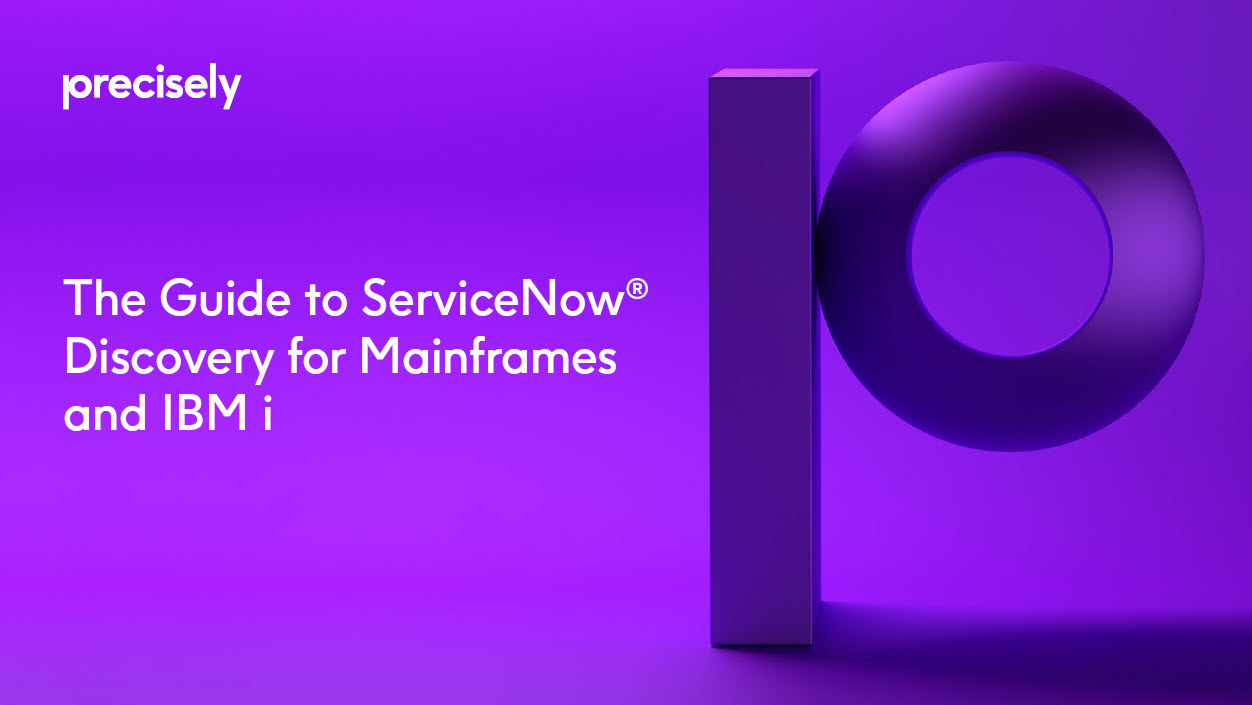eBook
The Guide to ServiceNow Discovery for Mainframes and IBM i
Read this eBook to understand how Ironstream™ software makes it easy and cost-effective to integrate data from isolated traditional IBM systems into ServiceNow Discovery.
Introduction
IT has changed markedly over the past decade. From a sprawling empire of distinct information siloes, IT is transitioning toward a more holistic and unified approach. Data can no longer be locked away. Information from all areas, whether structured or unstructured, must be shareable with other systems to facilitate automation and advanced analytics.
IT Operations Management (ITOM) solutions have evolved to satisfy this demand. They promise complete visibility into all areas of the infrastructure, and optimized management of IT environments.
The ServiceNow platform stands front and center in the ITOM marketplace. It provides a way to monitor operations, manage services throughout the enterprise, put together a single system of record for all IT assets and automate the discovery process for all IT assets. The platform ensures availability, improves efficiency and heightens the performance of processes and services, whether on-premise or in the cloud.
The discovery process is the foundation of ITOM. Only by maintaining an accurate and up-to-date catalog of all services, devices, networks, applications and storage can ITOM achieve its goals. As a result, organizations that do not work to encompass IBM mainframe and IBM i system data in ServiceNow are left with an incomplete picture that can lead to service slowdowns, troubleshooting delays and downtime. The discovery chasm that currently exists between mainframe/IBM i and other enterprise systems must be addressed if the full benefits of ITOM are to be realized.

ServiceNow and Discovery
One of the big reasons for the success of ServiceNow is the thoroughness of its built-in discovery processes. The ServiceNow Discovery module provides IT with visibility into most areas of the IT landscape and the constant changes it undergoes. This enables IT to discover physical and virtual devices such as laptops, desktops, servers, switches, routers, storage, as well as applications and the vast number of interdependent relationships between them. Whether on premises or in the cloud, ServiceNow identifies applications, cloud resources, container clusters and hardware, and offers dependency views that depict how IT resources relate to one another.
Based on a thorough mechanism for discovery, IT gains a robust mechanism for change management. By populating and updating the Configuration Management Database (CMDB) automatically, it becomes much easier to understand an organization’s IT environment, particularly in the areas of service impact analysis, asset management, compliance and configuration management.
ServiceNow harnesses the discovery process to gather information on computing resources, referred to as Configuration Items (CIs). Discovery locates all CIs and all their dependent relationships within on-premise systems or in public clouds like Amazon Web Services and Microsoft Azure. This process of discovery is done by ServiceNow on a regular and repeated basis to keep pace with the constant change that is the norm within enterprise IT. In this manner, ServiceNow ensures the CMDB is supplied with accurate information about the IT environment.
This up-to-date view of the enterprise facilitates ITOM in its efforts to speed incident resolution and monitor the health of business services. A correctly configured CMDB can save businesses as much as 40% in IT expenditure, while greatly reducing the possibility of unplanned outages. Functions such as incident management, service modeling, performance monitoring and troubleshooting require CMDB precision to operate effectively.
In other words, the CMDB can be considered a shared, single version of truth. It is a vital ingredient of service management, change management and asset management initiatives.
And that’s where the problem lies. The ServiceNow CMDB does not natively discover CIs from IBM i systems and IBM mainframes. Banks, healthcare, financial services, retail, government and a great many other organizations continue to rely upon IBM i systems and IBM mainframes to run mission-critical applications and databases. Only by incorporating data from these platforms into the ServiceNow CMDB can these enterprises ensure the integrity and reap the full value from their ITOM initiatives.
“ServiceNow harnesses the discovery process to gather information on computing resources, referred to as Configuration Items (CIs).”
Incomplete CMDBs Breed Uncertainty
The velocity of the modern enterprise necessitates a high level of automation. ITOM provides a means of automating many operational and managerial functions. But an incomplete CMDB can lead to incorrect actions by IT, wrongly targeted troubleshooting efforts and downtime. Once it is realized that the CMDB in ServiceNow is not populated accurately as it is not set up to discover CIs from all enterprise systems, uncertainty enters the scene.
IT then scrambles to fill the gap. It assembles a variety of rudimentary, manually gathered data stores such as spreadsheets, Visio diagrams and Microsoft Access databases to compensate for a lack of IBM i and IBM mainframe discovery. But the sheer number of interrelated IT components, configurations and changes make it difficult, if not impossible to stay up-to-date.
Further, the time-consuming nature of manual tracking typically means that such an activity is carried out infrequently – perhaps only once or twice per year. The likelihood, then, is that ServiceNow ITOM personnel referring to these manual workarounds will be operating on wildly out of date information.
Here are just a few of the consequences of failing to incorporate IBM i and IBM mainframe data into the ServiceNow CMDB:

Impact Analysis
Incidents are often created automatically when an abnormal situation is detected. It is then up to ITOM systems to determine if a specific incident had any impact on business services. Incorrect or outdated IBM mainframe/i discovery data can lead to wrong conclusions about the impact of an incident. For example, an incident to a multi-terabyte storage unit may not appear to be important as it is not currently connected to the systems discovered by ServiceNow. But if it supports mainframe services that have a dependency with enterprise ERP, rapid action is required to prevent a failure in the storage unit.
Root Cause Identification
Once the impact of an event has been defined as important, the next step is identifying its root cause. By reviewing the chain of interdependencies within the CMDB, the CIs that generated the event can be located. But if mainframe CIs and relationships are omitted, attempts to isolate the root cause may be in vain. Take the case of a delay in fulfilling an order. The CMDB should display the relationships between the procurement service, subservices and physical system components to help IT see which CIs could be causing the delay. If a mainframe dependency is involved and IT can only refer to a one-year old spreadsheet of mainframe data, errors are inevitable.
Change Governance
Change management ensures that procedures are used to handle changes, minimize the impact of changes upon service quality and improve day-to-day operations. Change governance utilizes the CMDB to ensure changes are implemented correctly. An incomplete CMBD that lacks mainframe/IBM i data may result in the implementation of harmful changes or can cause problems to other systems due to a lack of understanding of existing dependencies.
Auditing and Compliance
The CMDB should contain the logical architecture of the IT environment. Auditing and compliance efforts depend upon it as a single version of truth. But if IBM mainframe and IBM i data are omitted, auditing and compliance timeframes can be lengthened significantly. Instead of the data being clearly available to the auditor, manual verification must be conducted. This is not only time consuming, it opens the door to a greater possibility of inaccuracy.


Resource Optimization
Resource optimization includes software license management, inventory management and project management. The CMDB anchors each of these areas by consolidating resources based on the context of their usage and support for services. Let’s use the example of a server virtualization project to consolidate many physical servers in one location. If organizations fail to recognize the dependencies between some of those servers and IBM i systems, business services may be impacted. What appeared to be a simple server virtualization project could generate real performance and resource optimization issues.
Services Mapping
One of the major capabilities of a CMDB is the ability to represent an IT service or business service as a CI. This allows management to embrace a 360-degree view of service, whether in operations, finance, fulfillment, support or compliance. But without taking IBM mainframe and IBM i CIs into account, that 360-degree view is reduced to perhaps only a 270-degree view. The resulting blind spot means service mapping may fail to consider vital pathways through mission-critical systems.
Services Performance Planning
Performance planning for the implementation of services is another vital use case for the CMDB. Those engaged in the improvement of services may run into roadblocks if they take too narrow a view. A key aspect of performance planning is understanding existing relationships and dependencies. A ServiceNow CMDB that is not populated by IBM mainframe and IBM i CIs could result in IT being unable to identify the cascading effects of a subtle change in infrastructure. Performance could suffer badly as a result.


The Missing Link in ServiceNow
As discussed earlier, mainframe and IBM i systems remain a critical part of today’s businesses. 95 percent of the Fortune 500 companies, continue to use mainframes, about two-thirds of all business transactions for U.S. retail banks run on them, and mainframes host more than 70 percent of the world’s business-critical data.
Ironstream™ software seamlessly integrates the IBM i and z/OS data into the powerful ServiceNow platform. Ironstream™ software makes it possible for standard ServiceNow Discovery processes to populate and update the CMDB with data from these IBM systems. For the first time, it becomes possible to easily understand an organization’s entire IT environment, particularly in the areas of service impact analysis, asset management, compliance and configuration management.
By implementing Ironstream™ for ServiceNow, those deploying the ServiceNow CMDB possess a single system of record and a single source of truth for IT. They gain full visibility into their infrastructure and services, leading to more control of their environment and better decision-making. By incorporating IBM i and IBM mainframe information, they can fully leverage their investments into ServiceNow, automate tasks and expand its capabilities.
With Ironstream™ for ServiceNow, insights that were previously not possible are now made available, including:
Impact Analysis
With a complete CMDB that stores and understands relationships between CIs in all systems within the organization, mainframe/IBM i relationships with other enterprise systems are suddenly visible. That helps IT to understand the relative importance of an incident such as a storage unit that was shut down in the middle of the night. It becomes easy to see if it is a real emergency or only a minor event.
Root Cause Identification
IT analysts can determine if the cause of problems such as a delivery delay stems from within the mainframe or lies is with other enterprise systems. Root cause identification based on complete data goes a long way to maintaining the viability of IT to support the business.
Resource Optimization
For a server virtualization project, an up-to-date CMDB within ServiceNow would quickly make it apparent that one of the servers to be consolidated had deep dependencies with IBM i servers on the back end. Understanding these relationships, the server optimization plan would be adjusted to either include those dependencies or that server could be omitted from the virtualization project. By incorporating mainframe/IBM i CIs into the CMDB, the risk of unforeseen outcomes and expenditures can be avoided.
Summary
Discovery is foundational to IT Operations. The CMDB is the single system of record for your entire IT infrastructure, underpinning all your ServiceNow apps. You can’t leave out your mainframes and IBM i systems.
Ironstream™ software seamlessly integrates with ServiceNow Discovery to make it easy to incorporate these traditional environments into the CMDB.
With Ironstream™ software support for ServiceNow Discovery, you get a single source of truth to optimize IT operations, without the complexity, time and risk of manual processes.
